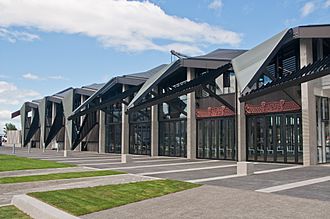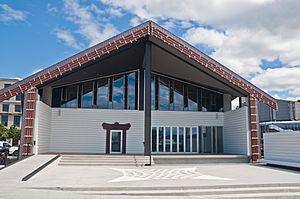Te Raukura facts for kids
Quick facts for kids Te Raukura |
|
|---|---|
 |
|
| Alternative names | Te Wharewaka o Poneke |
| General information | |
| Location | Wellington waterfront |
| Address | Odlins Square, 15 Jervois Quay, Wellington Waterfront |
| Coordinates | 41°17′21″S 174°46′47″E / 41.28922°S 174.77975°E |
| Design and construction | |
| Architecture firm | architecture + |
Te Raukura, also known as Te Wharewaka o Poneke, is a special building on the Wellington waterfront in New Zealand. Its name means "the waka house of Wellington." Inside, you'll find a place for meetings (called a whare tapere), a cafe named Karaka Cafe (whare kai), and a house for traditional Māori canoes (waka).
Contents
History of Te Raukura
Te Raukura is located right on the Wellington waterfront. It sits between the Civic Centre and Te Papa Tongarewa, which is New Zealand's national museum. The building is next to a lagoon called Te Whai Repo, near Frank Kitts Park. Other cool places nearby include the Wellington Museum and the City Gallery.
This building is very important to the descendants of the Taranaki iwi (tribes) like Te Atiawa, Taranaki, Ngati Ruanui, Ngati Tama, and Ngati Mutunga. The area where Te Raukura stands was once the harbour front for Te Aro Pā. This was one of the biggest Māori communities in Wellington until the 1880s. The building helps bring a Māori presence back to the waterfront, which had been missing for a long time.
Te Wharewaka o Pōneke was officially opened on Waitangi Day, Sunday, February 6, 2011. This was done with a special ceremony at dawn.
The building's unique design looks like a korowai, which is a traditional Māori cloak. This design shows respect and importance. The roofline of the korowai reminds people of the old sails used on waka (canoes). The building also has special carvings called whakairo. These carvings and modern designs make the building look like a ceremonial waka. It connects to the ancestor Kupe and the long history of Pacific voyaging. You can learn more about these stories on the waka and cultural walking tours.
Traditional Waka of Wellington
Traditional waka have returned to Te Whanganui a Tara (Wellington Harbour) recently. This includes the waka taua (war canoe) Te Rerenga Kotare and the waka tete Te Hononga. The newest waka is Poutu, named after Sam Jackson (Poutu Wipa). Poutu has a fibreglass hull, making it great for regular waka tours, along with Te Hononga. Te Rerenga Kotare is used for special events like Waitangi Day and ANZAC Day. These waka were built by Master Carver Hector Busby from ancient swamp kauri wood.
Te Rerenga Kotare: The War Canoe
Waka taua are the largest and most detailed single-hull canoes. Māori used them for important ceremonies and, in the past, as war canoes. The waka taua has a fancy carved front part called the tau ihu. These carvings can have many different designs, like the one from Taranaki. The main body of the waka is made from a single log. Its size depends on how big the log was.
When the waka is used for ceremonies, it has two poles sticking out from the front. These poles are covered with feathers and are called ihiihi. It also has two large "eyes" or karu atua, which look ahead. Having a waka taua shows independence, importance, and strength. The name, Te Rerenga Kōtare, means "flight of the kingfisher." The kingfisher is a bird that works hard and protects its own. When it flies, it is strong, balanced, and focused.
This waka needs a crew of about 18-20 male paddlers (kaihoe). It is used around Te Whanganui a Tara (Wellington Harbour) and sometimes travels to other places for waka races. For ceremonial events, the paddlers wear traditional raincapes called pake.
Te Hononga: The Binding Canoe
'Te Hononga' and 'Poutu' are waka tētēkura. These canoes represent the hopes and dreams of Māori ancestors. They show the connection between Māori and all people, welcoming everyone no matter where they come from. Both men and women can paddle these waka. It is hoped that these canoes will bring people, nature, and communities together, making Wellington proud.
Waka tētēkura are canoes used for many purposes, like fishing and transport. Te Hononga is not as heavily carved as Te Rerenga Kōtare. It has a special front part called a tētē. This part usually looks like a face with a tongue sticking out. The name "Te Hononga" means to connect or form friendships. In the past, waka tētēkura were mainly used for fishing and carrying people and goods. Today, Te Hononga is a multi-purpose waka that both men and women can paddle. Its hull is made from an old kauri tree found in the swamps of Te Taitokerau (Northland).
Poutu: The Modern Waka
Poutu was launched on Waitangi Day in 2014. It was built to remember Kaumatua (elder) Sam (Poutu Wipa) Jackson. This waka is fun to be on board and is quite comfortable. Its hull is made of fibreglass, making it strong, light, and durable. It also has beautifully carved Ihu (front) and Taurapa (back) parts.
Each paddler has lots of leg-room and can sit comfortably. Poutu has special compartments in the middle and at each end. These compartments help it float, even if it fills with water.


